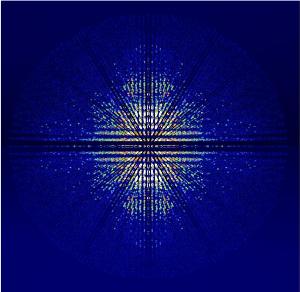Dec 18 2013
To trace and understand chemical and biological processes taking place in just some quintillionths of a second with full atomic detail: this is the goal of a research project of four scientists of the University of Hamburg, DESY, and Arizona State University receiving 14 million euros from the European Research Council ERC for the coming six years. In the context of this project, a new research facility will be established at DESY.
 Visualisation of diffraction data from photosystem I, a large membrane protein complex which is central to the process of photosynthesis. The data was obtained by combining individual diffraction "snapshots" from many thousands of tiny protein crystals acquired using the intense femtosecond X-ray pulses of the Linac Coherent Light Source (LCLS) in California. (Credit: Thomas White/CFEL/DESY)
Visualisation of diffraction data from photosystem I, a large membrane protein complex which is central to the process of photosynthesis. The data was obtained by combining individual diffraction "snapshots" from many thousands of tiny protein crystals acquired using the intense femtosecond X-ray pulses of the Linac Coherent Light Source (LCLS) in California. (Credit: Thomas White/CFEL/DESY)
With a so-called ERC Synergy Grant, the research council supports the project “Frontiers in Attosecond X-ray Science: Imaging and Spectroscopy” (AXSIS) of Professor Franz Kärtner (Center for Free-Electron Laser Science CFEL, DESY and University of Hamburg), Professor Henry Chapman (CFEL, DESY and University of Hamburg), Dr. Ralph Aßmann (DESY) and Professor Petra Fromme (Arizona State University).
This is the second funded ERC Synergy Grant involving the University of Hamburg and the Center for Free-Electron Laser Science, a cooperation of DESY, the University of Hamburg and the Max Planck Society. "My sincere congratulations to all involved scientists. It is an outstanding success that researchers from Hamburg have now succeeded for the second time in the premier class of the European Research Council," said Hamburg's Senator of Science and Research, Dorothee Stapelfeldt. "The second Synergy Grant for Hamburg is also a confirmation of our concept, to promote cooperation between university and non-university research in Hamburg."
On occasion of this success, University President Professor Dieter Lenzen said: “This is a fabulous result for the cooperation of the University of Hamburg and DESY. I congratulate the team of Professor Franz Kärtner, Professor Petra Fromme, Professor Henry Chapman and Dr. Ralph Aßmann on winning against 449 competing applications. The ERC grants are bestowed to outstanding scientists doing unique and convincing interdisciplinary and multidisciplinary research. Given the fact that – since the implementation of this instrument in 2012 – only a total of 25 applications out of 1160 were supported in both bidding rounds, the University of Hamburg is the most successful in Germany with two funded grants.”
Professor Helmut Dosch, Chairman of the DESY Board of Directors, congratulated the team: “This admirable success demonstrates the unique expertise which exists at DESY and among its partners. Jointly, we are able to realise the key technologies for the world of tomorrow.”
To be able to film ultra-fast processes in slow motion, the four scientists will develop a kind of stroboscope with ultra-short light flashes in the attosecond range. In one attosecond – this is one quintillionth of a second – light travels only 0.3 millionth of a millimetre. To reach atomic resolution, these light flashes will be in the short-wavelength X-ray region of the spectrum. This will allow insights into so far unobservable processes of nature. “The facility which will be built within the framework of the funded project will be included into a new research complex for accelerator science at DESY,” said Aßmann who is head of this research area in the context of the Helmholtz Accelerator R&D (ARD) programme. The attosecond source will be based on a novel, laser-driven particle accelerator technology which will emit X-ray radiation with much shorter pulses than possible today.
“The attosecond crystallography and spectroscopy with X-ray radiation, which currently is partially tested in the femtosecond range by Chapman and Fromme at the Linac Coherent Light Source in California, can not only completely resolve ultra-fast processes in real space but also in the energy domain,” said Kärtner, Professor for Free-Electron Laser Studies at the University of Hamburg, DESY research group leader at CFEL and Principal Investigator at the Hamburg Center for Ultrafast Imaging (CUI). This technology can revolutionise the understanding of structure and function at the molecular and atomic level and unravel fundamental processes in chemistry and biology, e.g. the dynamics of light absorption, of electron transport and of the protein structural changes during photosynthesis – one of the major unsolved problems of structural biology.
This makes this technology also relevant for many other fields of research, for example for the Center for Structural Systems Biology CSSB, which is currently being established as a cooperation of eight institutions on the DESY campus. Research groups at DESY, the Mid Sweden University and the Massachusetts Institute of Technology (MIT) are associated with the AXSIS project.